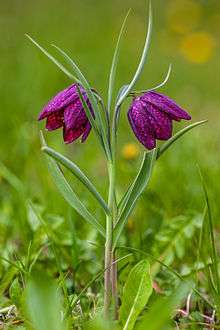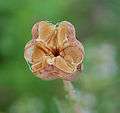Fritillaria meleagris
Fritillaria meleagris is a Eurasian species of flowering plant in the lily family.[2][3][4] Its common names include snake's head fritillary, snake's head (the original English name), chess flower, frog-cup, guinea-hen flower, guinea flower, leper lily (because its shape resembled the bell once carried by lepers), Lazarus bell, chequered lily, chequered daffodil, drooping tulip or, in northern Europe, simply fritillary.[5] The plant is native to the flood river plains of Europe where it grows in abundance.[6]
| Fritillaria meleagris | |
|---|---|
 | |
| Scientific classification | |
| Kingdom: | |
| (unranked): | |
| (unranked): | |
| Order: | |
| Family: | |
| Genus: | |
| Species: | F. meleagris |
| Binomial name | |
| Fritillaria meleagris | |
| Synonyms[1] | |
|
Synonymy
| |
Etymology
The name Fritillaria comes from the Latin fritillus meaning dice-box, possibly referring to the chequered pattern on the flowers[7] although this derivation has been disputed.[8] The name meleagris means "spotted like a guineafowl".[9] The common name "snake's head" probably refers to the somewhat snakelike appearance of the nodding flower heads, especially when in bud, on their long stems. Vita Sackville-West called it "a sinister little flower, in the mournful colour of decay".[8]
Description and habitat
The flower has a chequered pattern in shades of purple, or is sometimes pure white.[9] It flowers from March to May and grows between 15–40 cm (6–16 in) in height. The plant has a button-shaped bulb, about 2 cm in diameter, containing poisonous alkaloids. It grows in grasslands in damp soils and river meadows at altitudes up to 800 m (2,625 ft).
Distribution
Fritillaria meleagris is native to Europe and western Asia but in many places it is an endangered species that is rarely found in the wild but is commonly grown in gardens. In Croatia, the flower is known as kockavica and is associated by some with the country's national symbol.[10] It is the official flower of the Swedish province of Uppland, where it grows in large quantities every spring in the meadows of Kungsängen (King’s Meadow), just outside Uppsala, which gives the flower its Swedish name, kungsängslilja (king’s meadow lily). It is also found for example in Sandemar Nature Reserve, a nature reserve west of Dalarö in Stockholm Archipelago.
United Kingdom
In the United Kingdom there is some disagreement amongst botanists as to whether F. meleagris is a native species or a long-established garden escapee. The plant was first described in the 16th century by herbalist John Gerard who had only known of it as a garden plant and it was not recorded in the wild until 1736, which has led some to argue that it must be an escapee.[11] However, the fact that its habitat is usually confined to ancient hay meadows and it does not easily spread to adjoining land, leads others to the conclusion that it is a native species which became isolated from the European population when Britain was cut off from mainland Europe after the last glacial period.[11] Clive Stace (2010) says that it is "doubtfully native".[12]
The plant was once abundant in the UK, particularly in the Thames Valley and parts of Wiltshire, and was collected in vast quantities to be sold as a cut flower in the markets of London, Oxford and Birmingham. During World War II most of the ancient meadows were ploughed up and turned over to the production of food crops, destroying much of the plant's habitat.[11] A popular garden plant, it is now rare in the wild, although there are some notable sites where it is still found, such as the meadows at Magdalen College, Iffley Meadows,[13] Oxford and the Oxfordshire village of Ducklington,[11] which holds a "Fritillary Sunday" festival.[14] It is also found in the North Meadow National Nature Reserve, Wiltshire, Clattinger Farm Nature Reserve, Wiltshire[15] and Fox Fritillary Meadow and Mickfield Meadow nature reserves in Suffolk.[16][17][18] In 2002 it was chosen as the County flower of Oxfordshire following a poll by the wild flora conservation charity Plantlife.[19]
Cultivation
Now easily available as an ornamental spring bulb for the garden, it is commonly sold as a mixture of different coloured cultivars. The species[20] and the pure white-flowered variety F. meleagris var. unicolor subvar. alba[21] have gained the Royal Horticultural Society's Award of Garden Merit.[22]
Like many plants in the lily family, F. meleagris is susceptible to the scarlet lily beetle, which can seriously damage or kill it.
Gallery
- Fritillaria meleagris at the Botanical garden KIT, Karlsruhe, Germany
 A chequered flower
A chequered flower
 At Audubon's marsh, West France
At Audubon's marsh, West France- In Sandemar beach meadows, west of Dalarö, Sweden
 Ripe fruit
Ripe fruit.jpg) At Ovčar-Kablar Gorge, Serbia
At Ovčar-Kablar Gorge, Serbia Snake's Head Fritillary garden in April 2019 at the Kew Royal Botanic Gardens, Richmond, UK
Snake's Head Fritillary garden in April 2019 at the Kew Royal Botanic Gardens, Richmond, UK
Notes and references
- Kew World Checklist of Selected Plant Families
- Pavlov, N.V. (ed.) (1958). Flora Kazakhstana 2: 1-290. Alma-Ata, Izd-vo Akademii nauk Kazakhskoi SSR.
- Malyschev L.I. & Peschkova, G.A. (eds.) (2001). Flora of Siberia 4: 1-238. Scientific Publishers, Inc., Enfield, Plymouth.
- Altervista Flora Italiana, genere Fritillaria
- BBC Nature
- "Fritillaria meleagris - Plant Finder". www.missouribotanicalgarden.org. Retrieved 2020-07-04.
- Shorter Oxford English dictionary, 6th ed. United Kingdom: Oxford University Press. 2007. p. 3804. ISBN 978-0199206872.
- http://www.thepoisongarden.co.uk/atoz/fritillaria.htm
- Anon. "Gardens:Rosemoor:Fritillaria meleagris". Royal Horticultural Society website. Royal Horticultural Society. Archived from the original on 6 July 2010. Retrieved 29 April 2011.
- Petrovčić G. (2006-05-20). "Ugrožena kockavica, nacionalni simbol Hrvatske" [Kockavica, the national symbol of Croatia, is endangered]. Vjesnik (in Croatian). Retrieved 2011-02-08.
- Mabey, Richard; Produced by Susan Marling (10 July 2011). "Snake's Head Fritillary". Mabey in the Wild. Just So radio production for BBC Radio4. Retrieved 29 July 2011.
- Stace, Clive (2010). New Flora of the British Isles (3rd ed.). Cambridge, UK: Cambridge University Press. p. 857. ISBN 978-0-521-70772-5.
- Anon. "Iffley Meadows". Berks, Bucks & Oxon Wildlife Trust. Berks, Bucks & Oxon Wildlife Trust. Retrieved 26 April 2015.
- Onon. "Fritillary Sunday". St Bartholomew's Church. St Bartholomew's Church. Retrieved 29 July 2011.
- "Clattinger Farm Wildlife". Wiltshire Wildlife Trust. Archived from the original on 2014-04-07. Retrieved 2013-08-20.
- Fox Fritillary Meadow, Framsden, SSSI citation, Natural England. Retrieved 2013-05-30.
- Fox Fritillary Meadow, Suffolk Wildlife Trust. Retrieved 2013-05-30.
- Mickfield Meadow, SSSI citation, Natural England. Retrieved 2013-05-30.
- Plantlife website County Flowers page Archived 2015-04-30 at the Wayback Machine
- "RHS Plantfinder - Fritillaria meleagris". Retrieved 27 February 2018.
- "RHS Plant Selector - Fritillaria meleagris var. unicolor subvar. alba". Retrieved 23 February 2020.
- "AGM Plants - Ornamental" (PDF). Royal Horticultural Society. July 2017. p. 39. Retrieved 27 February 2018.
External links
| Wikimedia Commons has media related to Fritillaria meleagris. |